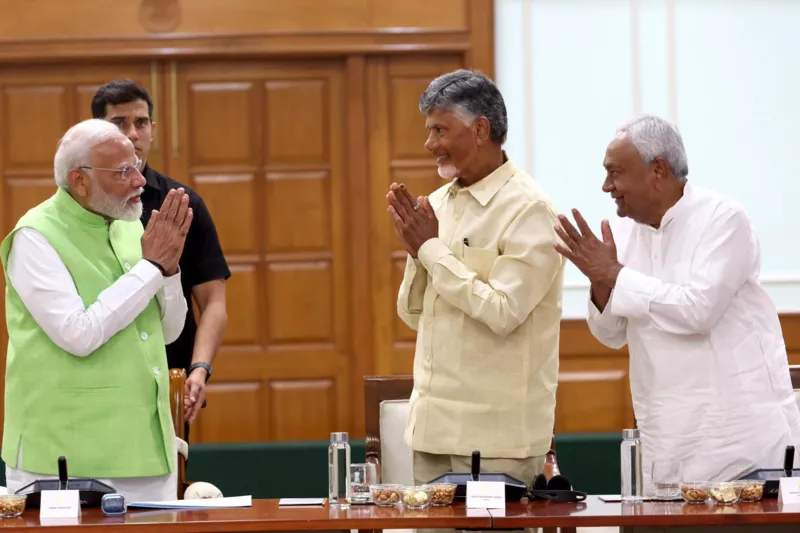India Faces a New Era of Coalition Politics
India, the world’s largest democracy, is no stranger to coalition governments. From 1989 to 2004, six general elections failed to produce a single-party majority, resulting in a series of coalition governments. These coalitions have ranged from chaotic and short-lived to remarkably successful, achieving significant economic reforms and high growth rates under both the Congress and Bharatiya Janata Party (BJP). Now, for the first time since 2014, India finds itself with a coalition government once more.
Modi’s Coalition Challenge
Prime Minister Narendra Modi, set for his third term, has seen his majority reduced by a resurgent opposition. The BJP now primarily relies on two key allies within the National Democratic Alliance (NDA) to secure a parliamentary majority. These allies, Janata Dal (United) and Telugu Desam Party (TDP), hold 28 seats between them and are led by seasoned politicians Nitish Kumar and N Chandrababu Naidu. Both leaders have had contentious relationships with Modi in the past, raising questions about how the prime minister will navigate this new political landscape.

Historical Context of Coalition Governments
India’s history of coalition governments provides a mixed but instructive backdrop. Between 1989 and 1999, eight coalitions were formed, many of which quickly collapsed. However, some of the country’s most significant economic reforms occurred under coalition rule. The period saw the liberalization of the economy, increased foreign investment, and infrastructural developments. Atal Bihari Vajpayee’s coalition government from 1998 to 2004, for instance, was marked by major initiatives such as privatizing state-owned firms, building expressways, and easing trade barriers.
Modi’s Leadership Style vs. Coalition Politics
Modi, known for his dominant and often polarizing leadership style, faces a significant test. Can he adapt to the demands of coalition politics, which require consensus-building and accommodation of diverse regional interests? Historically, Modi has governed with a majority both as the chief minister of Gujarat and as India’s prime minister, a period marked by decisive and sometimes unilateral decision-making.

The Role of Key Allies
The coalition’s stability hinges on the cooperation of key allies JD(U) and TDP. Both parties have a history of fractious relations with the BJP, particularly over Modi’s leadership style. Their leaders, Nitish Kumar and N Chandrababu Naidu, have previously withdrawn support from BJP-led coalitions over ideological differences. This background suggests that Modi will need to engage in substantial negotiation and compromise to maintain a cohesive government.
Potential Benefits of Coalition Governance
Many analysts believe that a coalition government under Modi could strengthen Indian democracy by decentralizing power and enhancing checks and balances. A coalition might mitigate Modi’s dominance, leading to more collaborative governance. It could also embolden the opposition and make institutions like the judiciary, media, and bureaucracy more independent.
Policy Challenges and Coalition Dynamics
Several contentious issues loom on the horizon. Modi’s BJP has proposed holding simultaneous federal and state elections, a plan that India abandoned in 1967. The party also supports the implementation of a Uniform Civil Code (UCC), a single personal law for all citizens regardless of religion, sex, gender, or sexual orientation. Both proposals are likely to meet resistance from coalition partners and the broader public.
Another significant issue is the redrawing of parliamentary boundaries, scheduled after 2026. Southern states, which are wealthier and less populated, fear that boundary changes could disproportionately favor the populous northern states, traditional BJP strongholds.

Economic and Social Imperatives
Despite a rebounding economy driven by government spending, India faces critical economic challenges. Modi needs to create jobs and boost incomes for the poor and middle class, necessitating structural reforms in agriculture, land, and labor. These reforms will require a consultative approach, making coalition politics not just a political necessity but also an economic imperative.
The Path Forward
Modi’s ability to adapt to coalition politics remains uncertain. Nilanjan Mukhopadhyay, a biographer of Modi, notes that the prime minister has never had to play the role of a coalition leader. Successful politicians, however, often master the art of reinvention. The coming years will reveal whether Modi can transform into a more consultative and consensual leader.
Conclusion
India’s return to coalition governance under Modi presents both challenges and opportunities. While the coalition could decentralize power and foster more inclusive governance, it will also require Modi to significantly alter his leadership style. As Sandeep Shastri, a political analyst, aptly puts it, “We will have to wait and see. We have to view this through the lens of current circumstances, not past alliances.”

